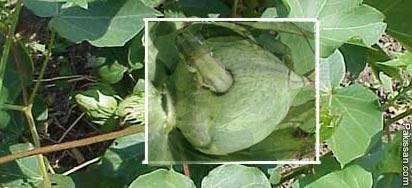|
Viral attack on cotton crop
By Saleem Shaikh
 Sindh’s
standing cotton crop, which remained unaffected by the
devastating floods, has now come under pest and viral
attacks, which may result in huge production losses. Sindh’s
standing cotton crop, which remained unaffected by the
devastating floods, has now come under pest and viral
attacks, which may result in huge production losses.
Mealy bug, leaf curl virus, army worm and red leaf
(reddening) disease have assaulted the crop on thousands of
acres in Naushero Feroz, Sanghar, Mirpurkhas, Badin and
Umkerkot districts.
Some 50 per cent area under cotton is reckoned to have been
destroyed by floods. The viral attacks may further reduce
the province’s overall cotton production.
According to official reports, a cultivation target of
6,50,000 hectares with a yield of 4.2 million bales was set
for the current fiscal year. But the crop on around 1,48,000
hectares has been lost by the recent deluge. The farm
leaders and officials in the provincial agriculture
department say that it is impossible to achieve the target.
“We had estimated the post-flood cotton output at around
2.8-3 million bales. But, following the viral attack on the
near-harvest crop, the output will not be more than two
million bales,” said an agricultural department official.
Farmers put the overall damage to crop from viral attack at
30-35 per cent. Agriculture experts point out various causes
for the outbreak of viral diseases, water shortage being the
major one.
“Late sowing due to water shortage, bad land management,
application of poor quality seed and fertilisers ,
adulterated DAP and fake pesticides and insecticides often
result in the outbreak of diseases like mealy bug, leaf curl
virus, army worm and reddening of leaves,” they said.
Farmers of Naukot in Mirpurkhas district, a major cotton
growing area, have come up with a flurry of complaints about
a disease that reddens the leaves, resulting in yield
losses.
Government officials in the plant protection department hold
bad land management and use of impure cotton seeds
responsible for the reddening disease. They said: “The
leaves begin to fall after they turn red and stop growth of
cotton plants.”
“Cotton crop on thousands of acres has been hit by the
reddening disease in the area and farmers, who obtained seed
and fertiliser on credit from local traders, have suffered
heavy financial losses,” said Allah Bux, a farmer leader in
Mirpurkhas district.
The mealy bug and reddening disease has also spread to
Sanghar, Badin and Umerkot districts. Amin Memon, a member
of a lower Sindh growers’ association, said more than 30 per
cent crop was damaged in these districts due to these
diseases.
“Persistent cloudy weather and reduced irrigation water to
cotton fields have been identified as the major reason
behind such diseases in these areas,” said Satidaan Singh
Sodho, executive district officer of agriculture department
in Badin.
Besides, the irrigation water rotation programme with long
intervals by area irrigation officials at a time when the
Indus River was in extremely flood during last more than 30
days, further aggravated water shortage in the cotton
growing districts, he said.
Agriculture officials of the affected districts told this
scribe on phone that in most of the areas of lower Sindh,
the cotton was sown two months late due to water shortage.
“April and May are the cotton sowing months. But owing to
severe water shortage, the farmers started sowing the crop
from mid -June and continued till August,” they said.
When water arrived in the areas, the growers said, they had
to make frantic efforts to cultivate cotton as much as
possible. “But, now our poorly cultivated crop has fallen
victim to various viruses due to low water availability and
cloudy whether,” said a grower.
Umerkot district remained hard-hit. The farmers started
cotton sowing only after it rained during early August. “We
were able to begin sowing cotton only after it rained
heavily in the first week of August, providing sufficient
water for growing the crop,” said a farmer of Umerkot
district.
But the happiness of growers in Umerkot was short-lived
after they saw their crop attacked by mealy bug, red leaf
disease and leaf curl virus. The growers claim that around
45 per cent of the crop in the district has been hit.
The situation of irrigation water in Sanghr district was
also not better either. The cotton growers blamed the
irrigation officials for creating artificial shortage in the
Nara canal, where the water was released from the Sukkur
Barrage. The canal irrigates over one million acres of
cotton in Sanghar, Nawabshah, Badin and Umerkot districts.
“Some 55 per cent of the one million acres were brought
under cotton sowing. But now most of it has been hit by
viral diseases. Consequently, the overall production in the
four major cotton-growing districts will drop by 40-45 per
cent,” estimates Akhund Ghulam Mohammad of the Sindh Chamber
of Agriculture.
Farmers say as no far-reaching efforts have been made by the
provincial agriculture department to control the problem,
the virus is spreading to standing crop in other areas,
particularly those in lower Sindh.
But, agriculture officials of the affected districts claim
that cotton disease control teams have been dispatched to
tackle the problem.
Agriculture officials of the affected districts have
confirmed the arrival of teams of plant protection
department, but some growers doubt whether they are capable
enough to bring the situation under control.
“They just come, survey the affected fields and hand out
pesticide prescriptions to the financially battered farmers.
No other help is provided. This is not going to help the
cotton growers fight the viral attacks effectively. Because
most of the disease-controlling pesticides they advise are
either unavailable or do not help,” said an official at the
Benazirabad district agriculture office.
Akhund Ghulam Mohammad believes that even if the disease is
controlled now, it would be of no advantage. For, it is too
late and the picking season has already set off.
Courtesy: The DAWN
|
Pakissan.com;
|